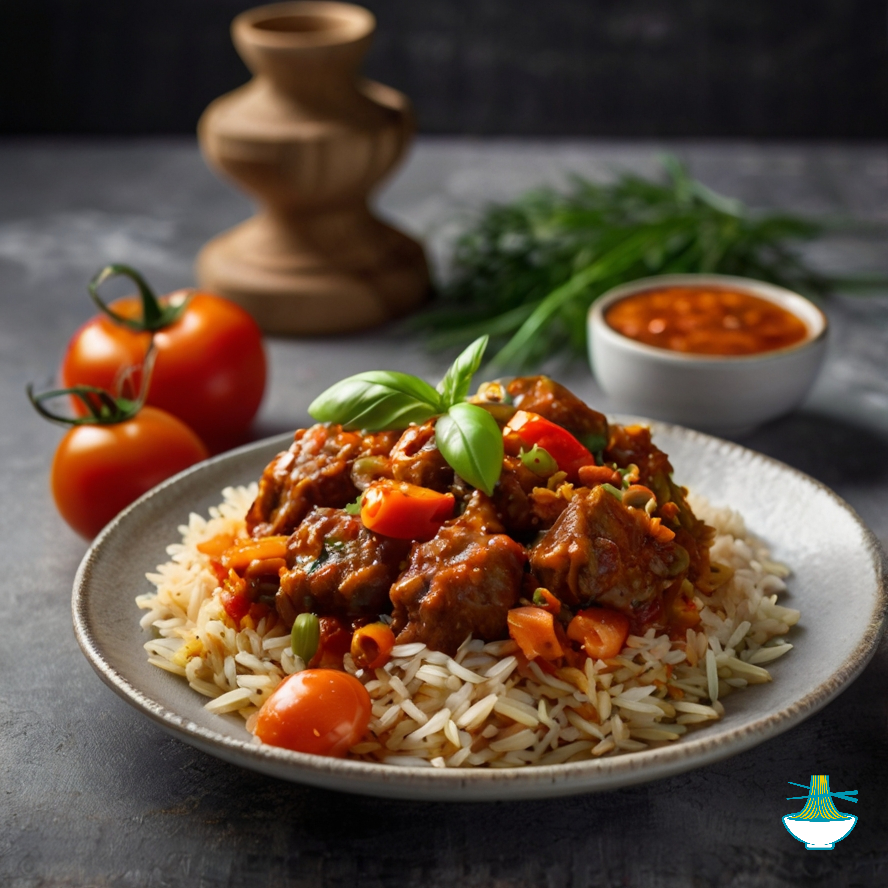Discover the delicious Riz au Gras, a classic dish featuring tender rice cooked with flavorful meat and fresh vegetables in a rich, spiced tomato sauce. Perfect for a hearty family meal, this recipe combines savory spices and wholesome ingredients to create a comforting and satisfying dish. 
Ingredients:
- 2 cups basmati rice
- 500g beef or lamb, cut into cubes
- 2 tablespoons vegetable oil
- 1 large onion, finely chopped
- 3 cloves garlic, minced
- 2 large tomatoes, chopped
- 1 bell pepper, chopped
- 1 cup carrots, diced
- 1 cup green beans, chopped
- 2 teaspoons ground cumin
- 1 teaspoon ground coriander
- 1 teaspoon paprika
- 1/2 teaspoon ground turmeric
- 1/2 teaspoon black pepper
- 1 teaspoon salt (or to taste)
- 4 cups beef or vegetable broth
- 1/4 cup fresh parsley, chopped (for garnish)
Instructions:
Prepare the Rice: Rinse the basmati rice under cold water until the water runs clear. Soak in water for 30 minutes, then drain.
Cook the Meat: In a large pot, heat the vegetable oil over medium heat. Add the cubed meat and brown on all sides. Remove the meat and set aside.
Sauté the Vegetables: In the same pot, add the chopped onion and garlic. Sauté until the onion becomes translucent.
Add Tomatoes and Spices: Stir in the chopped tomatoes, cumin, coriander, paprika, turmeric, black pepper, and salt. Cook for about 5 minutes, until the tomatoes break down and the mixture is fragrant.
Combine Meat and Vegetables: Return the browned meat to the pot. Add the bell pepper, carrots, and green beans. Stir well to combine.
Simmer: Pour in the beef or vegetable broth. Bring to a boil, then reduce the heat to low. Cover and simmer for 45 minutes to 1 hour, until the meat is tender and the vegetables are cooked through.
Add Rice: Stir in the drained rice, making sure it is well distributed in the pot. Cover and cook on low heat for an additional 20 minutes, or until the rice is fully cooked and has absorbed the flavors.
Garnish and Serve: Fluff the rice with a fork. Garnish with chopped parsley and serve hot.
Enjoy this comforting and flavorful Riz au Gras as a perfect meal for family gatherings or a special dinner!
Nutritional Values
Basmati Rice (2 cups)
- Calories: 200 kcal
- Protein: 4g
- Fat: 0.5g
- Carbohydrates: 45g
- Fiber: 0.6g
Benefits:
- Energy: Provides a good source of carbohydrates for energy.
- Low in Fat: Minimal fat content makes it a light option.
Beef or Lamb (500g)
- Calories: 250 kcal
- Protein: 26g
- Fat: 20g
- Carbohydrates: 0g
Nutritional Values (per 100g lamb, cooked):
- Calories: 294 kcal
- Protein: 25g
- Fat: 23g
- Carbohydrates: 0g
Benefits:
- Protein: Essential for muscle growth and repair.
- Iron: Good source of heme iron, important for red blood cell production.
Vegetable Oil (2 tablespoons)
- Calories: 120 kcal
- Fat: 14g
- Saturated Fat: 2g
Benefits:
- Cooking: Used to sauté the ingredients, adding flavor and texture.
Onion (1 large)
- Calories: 44 kcal
- Protein: 1g
- Fat: 0g
- Carbohydrates: 10g
- Fiber: 1g
Benefits:
- Antioxidants: Contains antioxidants that help reduce inflammation and support immune health.
- Flavor: Adds depth and sweetness to the dish.
Garlic (3 cloves)
- Calories: 12 kcal
- Protein: 0.6g
- Fat: 0g
- Carbohydrates: 3g
Benefits:
- Immune Support: Contains compounds that support the immune system.
- Flavor: Enhances the overall taste of the dish.
Tomatoes (2 large)
- Calories: 44 kcal
- Protein: 2g
- Fat: 0.5g
- Carbohydrates: 10g
- Fiber: 1.5g
Benefits:
- Antioxidants: Rich in lycopene, which may help reduce the risk of certain diseases.
- Vitamins: Provides vitamins C and A.
Bell Pepper (1 large)
- Calories: 30 kcal
- Protein: 1g
- Fat: 0g
- Carbohydrates: 7g
- Fiber: 2g
Benefits:
- Vitamins: Excellent source of vitamins A and C.
- Antioxidants: Contains various antioxidants that support overall health.
Carrots (1 cup, diced)
- Calories: 52 kcal
- Protein: 1g
- Fat: 0.3g
- Carbohydrates: 12g
- Fiber: 3g
Benefits:
- Vitamin A: Rich in beta-carotene, which supports eye health.
- Fiber: Contributes to digestive health.
Green Beans (1 cup, chopped)
- Calories: 31 kcal
- Protein: 2g
- Fat: 0g
- Carbohydrates: 7g
- Fiber: 3g
Benefits:
- Vitamins and Minerals: Provides vitamins A, C, and K, as well as important minerals like iron and calcium.
- Fiber: Supports digestive health.
Ground Cumin (2 teaspoons)
- Calories: 8 kcal
- Protein: 0.4g
- Fat: 0.4g
- Carbohydrates: 1g
Benefits:
- Digestive Health: Can aid in digestion and improve gut health.
- Flavor: Adds a warm, earthy flavor.
Ground Coriander (1 teaspoon)
- Calories: 5 kcal
- Protein: 0.2g
- Fat: 0.3g
- Carbohydrates: 1g
Benefits:
- Antioxidants: Contains antioxidants that may reduce inflammation.
- Flavor: Adds a mild, citrusy flavor.
Paprika (1 teaspoon)
- Calories: 6 kcal
- Protein: 0.3g
- Fat: 0.3g
- Carbohydrates: 1g
Benefits:
- Vitamin A: Provides vitamin A, which supports vision and immune function.
- Flavor: Adds a mild, sweet heat.
Ground Turmeric (1/2 teaspoon)
- Calories: 6 kcal
- Protein: 0.2g
- Fat: 0.2g
- Carbohydrates: 1g
Benefits:
- Anti-Inflammatory: Contains curcumin, known for its anti-inflammatory properties.
- Flavor: Adds an earthy, slightly bitter flavor.
Black Pepper (1/2 teaspoon)
- Calories: 3 kcal
- Protein: 0.1g
- Fat: 0g
- Carbohydrates: 1g
Benefits:
- Enhances Absorption: Can improve the absorption of nutrients.
- Flavor: Adds a sharp, spicy heat.
Salt (1 teaspoon)
- Calories: 0 kcal
- Sodium: 2,300 mg
Benefits:
- Flavor Enhancer: Improves the taste of the dish.
- Electrolyte Balance: Helps maintain fluid balance (use in moderation).
Beef or Vegetable Broth (4 cups)
- Calories: 15 kcal
- Protein: 1g
- Fat: 0.5g
- Carbohydrates: 1g
Nutritional Values (per cup, vegetable broth):
- Calories: 10 kcal
- Protein: 0.5g
- Fat: 0g
- Carbohydrates: 2g
Benefits:
- Flavor: Adds depth and richness to the dish.
- Hydration: Contributes to the liquid content of the dish.
Fresh Parsley (1/4 cup)
- Calories: 1 kcal
- Protein: 0.1g
- Fat: 0g
- Carbohydrates: 0.2g
Benefits:
- Vitamins: Provides vitamins A, C, and K.
- Flavor: Adds a fresh, herbal flavor.
This combination of ingredients provides a balanced, flavorful dish with a variety of nutrients, including protein, vitamins, and minerals.


Comments